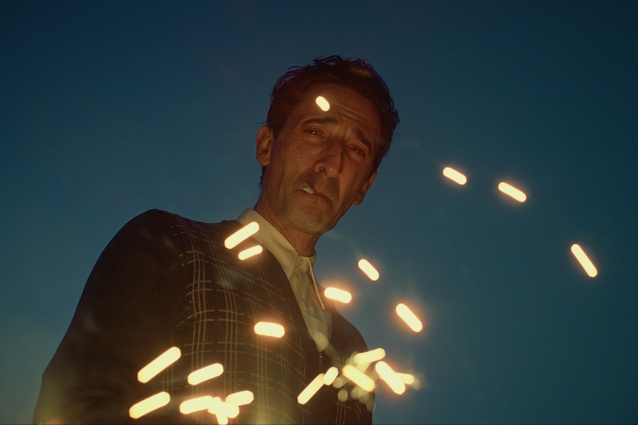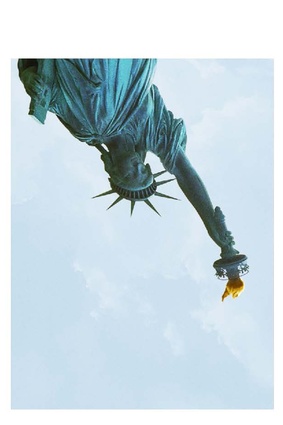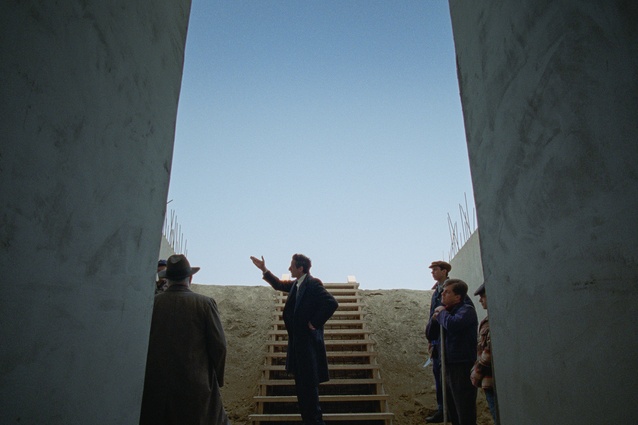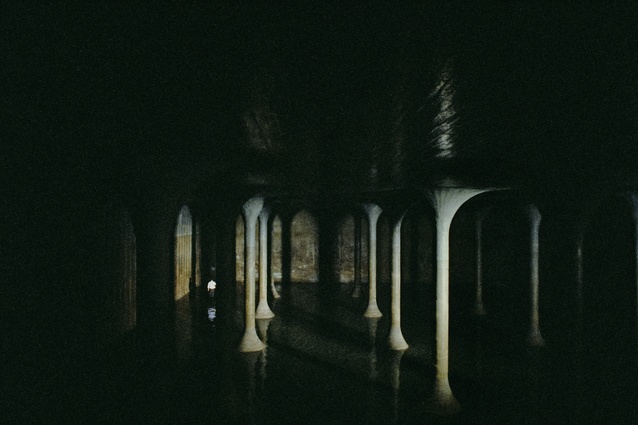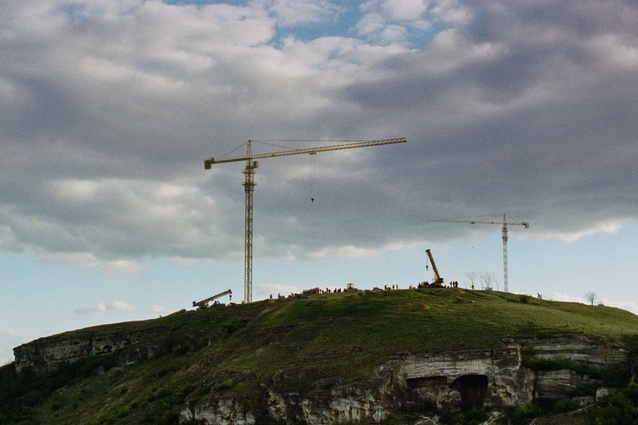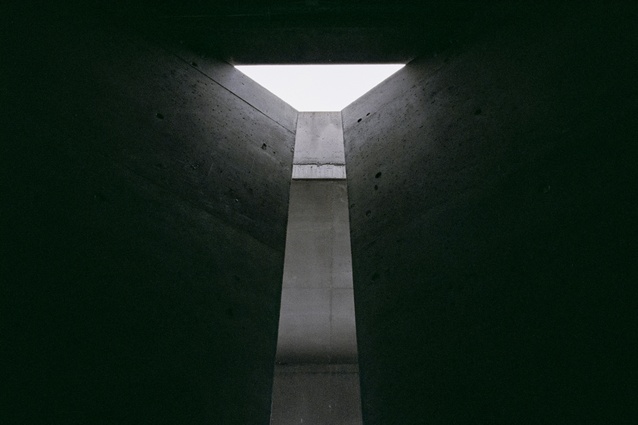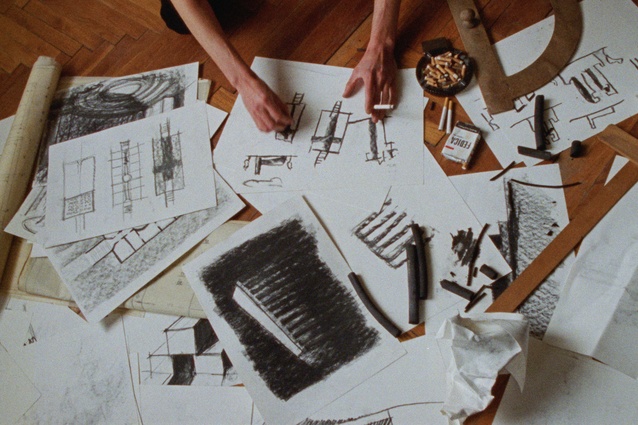The Brutalist: Form over function
Patrick Sherwood considers the recently released Golden Globe-winning and Oscar-nominated film, The Brutalist, and finds it to be a story disappointingly light on Brutalism, but full of promise and complexity.
Overture
As László Tóth (Adrien Brody) steps out of a darkened interior alongside hundreds of crammed passengers, we are unsure where we are, this Jewish émigré, where is he going? To Buchenwald? To capture or freedom? Around him, people hurriedly find their belongings and push through the crowds through metal doors.
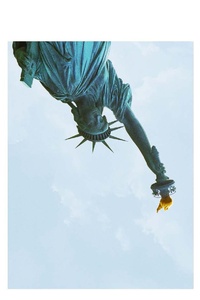
From the depths, he emerges into light, the camera frantically searching for the sky, and in a shot that will no doubt continue to be talked about, into frame lurches an inverted Statue of Liberty, her flame held upside down against a soaring backdrop of bombastic brass and clanging steel, the grey sky behind her holding just a hint of blue.
This introduction kicks off László’s difficult arrival to the New World, fleeing first Nazi then Soviet oppression in his native Hungary. In Europe, he leaves behind his forcibly separated wife and niece, along with an impressive backlog of architecture (famous modernist buildings are shown to be his work), arriving in America as a nobody, stuffed into a steamship like livestock.
Part 1: Enigma
Struggling to get on his feet, working first in his cousin’s furniture store, László eventually earns patronage with a new-money businessman, Harrison Lee Van Buren (Guy Pearce), who is enamoured by the architectural features about Tóth in European journals. Harry is impressed by László’s education at Bauhaus, his obvious professional brilliance, and his poetic musings about architecture, saying multiple times: “I find our conversations intellectually stimulating.” What better comment can you get from a client?
Harry commissions Tóth to design a memorial community centre for his late mother, the Van Buren Institute, which also requires a Christian chapel to get sufficient funding and community support. On this, at least, László is willing to compromise.
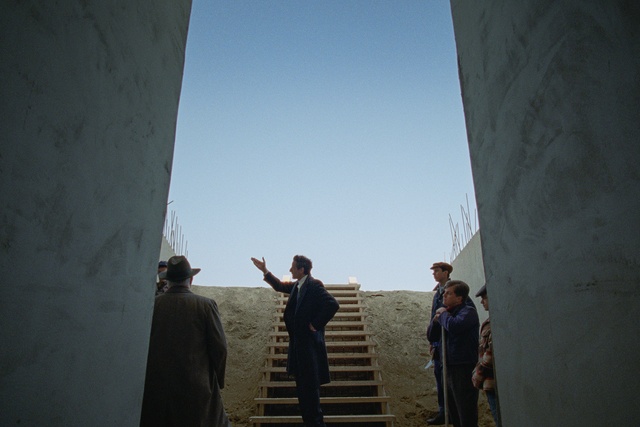
The film’s strongest sections are devoted to the architectural process: client meetings discussing prices and timelines, community presentations soliciting support, tense site meetings between contractor and architect, or perhaps most cathartically when pressured by another architectural consultant brought in to value engineer the project Tóth provokes him, staring him straight in the eye and proclaiming, “Everything that is ugly, cruel, stupid — but, most importantly, ugly — is your fault.” Amen.
These practicalities and politics, the bureaucracy involved, provide a fantastic vehicle for exploration of the artist-patron relationship between Tóth and Van Buren, whose equally friendly and yet toxic dynamic is a highlight, wonderfully acted by Brody and Pearce.
Van Buren is not only reverent and attracted to the architect’s talents but also jealous and deprecating of him. On the other hand, Tóth’s thoughts about his client remain mostly an enigma, he feigns and genuflects, working diligently and obsessively, taking the help offered to get his wife Erzsébet (Felicity Jones) and niece Zsófia (Raffey Cassidy) into America.
Their rich benefactor/service provider dynamic plays out as an example of the Jewish immigrant experience in post-war America. The family is welcomed into the wealthy country home so long as they know their place, maintain their victimization, and compromise themselves in order to fit in. To flourish, he must shed his identity like his cousin Attila who has Anglicized his surname and converted to Catholicism. He, the Jew, the immigrant, is not wanted in America, but his labour and his talents are.
Though it’s a shame Tóth’s Hungarian roots are a non-factor, getting little more than passing mention, and any important historical events such as the 1959 Revolution go by unmentioned. László seems not to have a political bone, but his wife Erzsébet, as a foreign affairs journalist, would surely have something to say? Considering the film went to lengths to ensure native pronunciation, controversially using generative AI to overdub the Hungarian spoken by English actors.
However, with the already sprawling themes and story it is understandable it centres thematically on America, for despite being billed as an “architectural” movie, the adage about American fiction always being really about America again rings true.
Intermission
Writers Brady Corbet and Mona Fastvold chose to structure the three-and-a-half-hour movie with a built-in intermission, overture, and epilogue. This, along with filming in VistaVision, was a homage to mid-century cinema, as well as a self-aware justifying itself as capital-c Cinema.
The film’s bold formalism is no accident, like brutalist or modernist architecture, it is unrelenting and uncompromising in style.
So too, Tóth’s building reflects the same structure: the Van Buren institute has multiple functions all programmed together, joined by an underground corridor providing access but also a conceptual unity between parts. This corridor, in fact, Tóth has to fight for, ultimately forgoing his fee to ensure the high ceilings (20m in places) and subterranean access remain. A nice thesis statement for the film overall, as the building’s construction is an analogy for the film’s own. Corbet said as much in an interview:
“Architecture and filmmaking have a lot in common because it takes roughly the same amount of people to construct a building or make a movie. The Brutalist, for me, was a way of talking about the more bureaucratic aspect of the artistic process.”1
To hammer this home, whilst Tóth and Van Buren share a glass of brandy in a wood-panelled room, the businessman asks, “Why architecture?” to which the architect replies, “Is there a better description of a cube than that of its construction?”
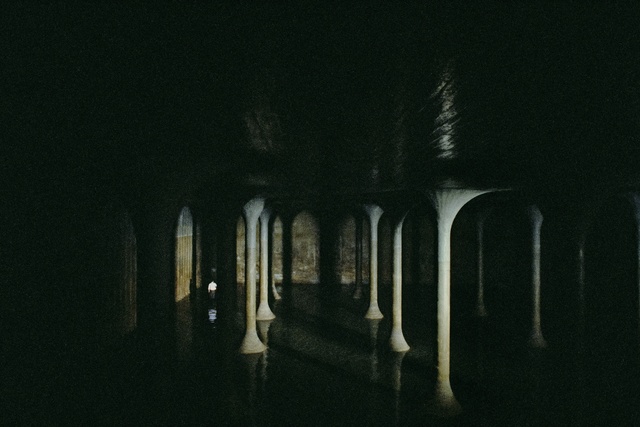
It is not difficult to see Corbet’s own metafictional motivations here, the disparate themes of Zionism, immigrant experience, architecture, drug addiction, patronage, are all boxed up, joined into this unifying package, a film analogizing its own creation into some recursive totality. There is certainly overarching verisimilitude, but on the whole, does this form express its function as brutalism would expect?
Part 2: Beauty
The Brutalist is no doubt a beautiful film, the aesthetic cinematography, the stylish Bauhaus titles and credits, and the score deserves a special mention, from the pulsing orchestral overtures to frantic bebop, interweaved with metallic machine noises, the sounds of industry and progress, present a time of rebuilding and growth, of promise and disappointment.
Yet, despite this promise, the film’s second half loses focus and tact, characters become empty symbols, forgetting the earlier themes in favour of an overdone and underwhelming conclusion. Because this isn’t a film about architecture, nor brutalism.
Even the obvious predatory client is problematic to its own thesis. Of course, Van Buren is exploiting and manipulating László, lording his control over this genius, both professionally and personally, but that is the bargain artists, architects, creatives must make. Barring the unnecessary climax, their relationship is an honest portrayal of the real dynamic of patron and artist.
Harry, for all his faults, the rage brewing barely skin deep, the enjoyment of dominating those around him, is as near to a dream client one could realistically hope for. László is given carte blanche, a large budget, and generous compensation to run a career-defining project. And when later pressured to find some cost-savings which are relatively minor, he refuses entirely, justifiably, but still.
Whilst not a monologuing maniac like Howard Roark, Tóth is presented as a visionary auteur supposedly without precedent, who imposes his own will on the project, regardless of anyone else’s input. Did the client and community ask for a monument to the architect’s own experience in Buchenwald concentration camp to shadow over their town? Should a physical manifestation of him processing his trauma trump the needs and desires of the building’s users?
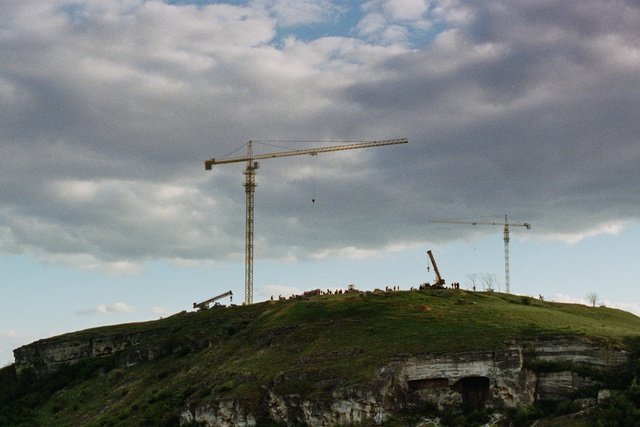
This notion of “the architect” is an outdated one, a 20th-century caricature of a lone genius blazing ahead without regard for budget, client, or context, a constructed combination of Corbusier, Gropius, Lloyd Wright, and Breuer, which seems more applicable to cinema than construction. A director projecting their auteur fantasies onto another profession.
So. too, Tóth’s building is a caricature, a vague stack of concrete boxes on a green hill, appearing like a blocky deconstructed cathedral, a towering series of empty chambers, echoing Tadao Ando crossed with a minimalist Pantheon interior, rather than real 1950s brutalism, even less an actual community centre.
The production designer, Judy Becker, who does not have an architectural background, talked about Ando as an influence, whilst forgoing much actual historical research, “I didn’t look at many architectural references because I didn’t want to be influenced by too much. I wanted to come up with something on my own.”2
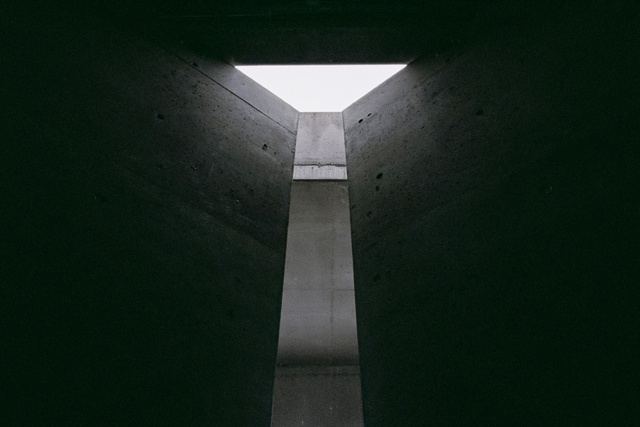
This admission is telling. The design feels anachronistic, far too minimal and contemporary, and lacking any of the ideological commitments integral to the historical movement to feel genuine. Brutalism, despite the popular perception, does not simply mean concrete. As the Smithsons’ quote goes, it is an “ethic, not an aesthetic.”
Tóth’s version is not brutalism. Yes, it uses béton brut, but where is the expression of function, the ‘honesty,’ the humbleness integral to its philosophy? The film conflates brutalism with mere brutality, turning the architect’s design into a metaphor for his personal trauma rather than an expression of its intended purpose, which is in fact the exact opposite of what brutalism as a utopian movement (for better or worse) intended.
Close ups of the building are in fact multiple real brutalist projects across Budapest, which are obviously far better, far more accurate examples of the style than the smooth, computer-rendered wide shots of the Institute. The scheme never stops feeling like a rushed first concept churned out hours before crit.
This disjoint between moments showing actual textural poetics and a vague harsh exterior is counter to Tóth’s very philosophy of showing the construction, the unity, the wholeness. Was this, ironically, a result of budget?
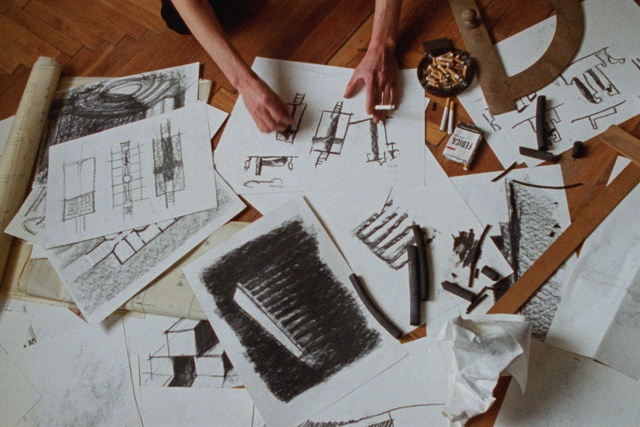
For a film named The Brutalist and centring primarily around a singular building, to have it manifest as both ugly and ill defined, but most importantly, ugly, is another cruelty inflicted on Tóth. Perhaps the vagueness, the dis-unity, the lack of concreteness, is symptomatic of the film as a whole.
Epilogue
Tóth, now elderly, remains silent in a wheelchair at the 1980 Venice Biennale, an exhibition of his career’s work (which also used generative AI to draw actual brutalist designs) being presented an achievement award. His grown-up niece delivers a speech, interpreting the Van Buren Institute as a replication of his experience in the Buffenwald concentration camp, down to using the same barracks dimensions and camp layout. Only the high ceilings, pushed up to allow a clerestory window band, are added, supposedly symbolizing freedom and equality.
Did we see this connection beforehand? Is this meant to be an accurate account of Tóth’s motivations in designing the Institute, or is this an ironic commentary on the dissection and interpretation of artists’ work by later figures, spinning and weaving their own narratives into history? The latter would make a nice meta-commentary on the writing-in of trauma to a historical style which has no connection to the Holocaust. However, given the film’s general lack of subtlety, I tend to the former interpretation.
We rarely have such high-profile films dedicated to architectural craft, and in many ways The Brutalist succeeds, the first half is fantastic, the pace riveting, the score rousing. And between the positive post-war progressive search for everything new and modern by Van Buren, and the heavy burden carried by Tóth is fascinating as a contrast of attraction and repulsion.
Unfortunately, the conclusion reached, that “this country is rotten” is proven inaccurate by the many real designers who also fled from Bauhaus, like Walter Gropius, Marcel Breuer, Mies Van Der Rohe, or another László: Moholy-Nagy, many of whom continued having highly distinguished and influential careers in America and abroad.
That is not to downplay the very real antisemitism experienced, or to denigrate the extra challenges they had to overcome, but rather to encourage Tóth taking more after these real-life figures so he would be less of a walking symbol designed to critique contemporary society.
To finish, Zsófia’s closing remark that “no matter what the others try to sell you, it is the destination, not the journey,” is indeed apt, for where The Brutalist arrives is, like the America Tóth finds, rather a disappointment.
References
1 hollywoodreporter.com/movies/movie-news/the-brutalist-brady-corbet-making-of-interview-1235995475/
2 archinect.com/features/article/150458277/the-brutalist-is-a-cinematic-reflection-of-brutalism

